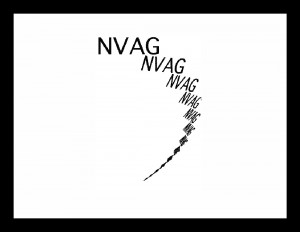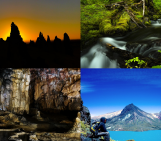To celebrate this year’s General Assembly theme – A voyage through scales – Shaun Lovejoy, President of the Nonlinear Processes in Geosciences Division (NP), takes us on a tour of how scaling might change our view in a range of Earth science topics: from clouds through to geological surfaces.
When van Leeuwenhoek peered through the first microscope, he was amazed at the new worlds lurking in a drop of water. That was the 17th century and today’s atom-imaging microscopes are developed precisely because of the promise of such discoveries. This contemporary scale-by-scale “newness” idea was graphically illustrated by K. Boeke’s “Cosmic View” (1957) which starts with a photograph of a girl holding a cat, first zooming away showing the surrounding vastness of space, and then zooming in until reaching the nucleus of an atom. Even better known is the derivative TV series and book by P. Morrison (“Powers of ten”, 1983), which encouraged the idea that nearly every power of ten in scale hosted different phenomena. This “new worlds” paradigm could also be termed “scalebound”; it is a severe constraint on one’s conceptual horizons [Mandelbrot, 1981]. From here, it is a short step to the “phenomenological fallacy”: the confounding of form and mechanism which we discuss below [Lovejoy and Schertzer, 2007].
![Schematic diagram showing a typical phenomenologist’s view of meteorology (reproduced from [Atkinson, 1981] who adapted it from [Orlanski, 1975],). The straight line, added in [Schertzer et al., 1997], is the Kolmogorov scaling ≈-1/3 l2/3 where the interpretation has been made that the lower right corner of the inner frame is 2 m and 10 s, whereas the upper left intersection of the inner frame with the extension of the line corresponds to one month. This corresponds to a turbulent energy flux ≈ 4x10-3 W/Kg which is a close to the global average ≈ 10-3 W/Kg estimated in [Lovejoy and Schertzer, 2013]. Note that the beginning of the transition from “synoptic” to “climatological scales” corresponds to planetary spatial scales, as required in order to explain the weather/ macroweather transition.](https://blogs.egu.eu/geolog/files/2015/04/Shaus-blog-post-1024x791.jpg)
Fig 1. Schematic diagram showing a typical phenomenologist’s view of meteorology (reproduced from [Atkinson, 1981] who adapted it from [Orlanski, 1975],). The straight line, added in [Schertzer et al., 1997], is the Kolmogorov scaling where the interpretation has been made that the lower right corner of the inner frame is 2 m and 10 s, whereas the upper left intersection of the inner frame with the extension of the line corresponds to one month. See Lovejoy and Schertzer, 201 for further details. Note that the beginning of the transition from “synoptic” to “climatological scales” corresponds to planetary spatial scales, as required in order to explain the weather/ macroweather transition.
These early scaling models were novel and striking, but they suffered from two limitations that ultimately made them unrealistic: they were simultaneously “monofractal” and “self-similar”. The first implies that strong and weak phenomena have the same morphologies whereas the second implies that the rule that allows us to zoom from large to small is the same in all directions (isotropic): the small and large are statistically carbon copies. But clouds have notoriously complex anisotropies and even casual inspection discloses that they tend to become flatter at larger scales, while being more wispy, filamentary at smaller scales (see the figures below). Indeed, by the 1980’s meteorologists had formalized the idea that atmospheric phenomena were qualitatively different over each factor of 10 in scale. The far right column in fig. 1 lists the scale ranges in Orlanski’s influential classification and fig. 2 shows a more recent example; such “space-time” or “Stommel” diagrams have adorned meteorology textbooks for decades. For the topography, geomorphologists had similarly catalogued complex anisotropic terrain structures and textures that also changed with scale.
![A Stommel diagram showing the length and time scales associated with typical atmospheric and oceanic dynamics, adapted from [Steele, 1995] (fig. 8.9b of [Lovejoy and Schertzer, 2013])](https://blogs.egu.eu/geolog/files/2015/04/shaus-blog-post-2-300x232.jpg)
Fig 2. A Stommel diagram showing the length and time scales associated with typical atmospheric and oceanic dynamics, adapted from [Steele, 1995]. You can read more about the diagram in Lovejoy and Schertzer, 2013.
Ultimately, it fell upon the shoulders of a few die-hards to seize on the kernel of scaling wisdom – that unique dynamical mechanisms could yield structures spanning wide ranges of scale – to build more realistic models. By the time the key anisotropic and multifractal generalizations of scaling had been developed, activity was concentrated in the newly formed Nonlinear divisions of the European Geophysical Society (1989) and the American Geophysical Union (1997).

zooming must be made anisotropic – so that for example changing from one scale to another involves not only enlarging/shrinking but also rotations and squashing of structures.
The key to producing realistic wide scale range models – to overcoming the phenomenological fallacy – turned out to be to generalize the notion of scale and scale changes, to go beyond isotropic zooms and self-similarity (additionally, multifractals are needed to overcome the limitations of monofractals, but that’s another story). The zooming must be made anisotropic – so that for example changing from one scale to another involves not only enlarging/shrinking but also rotations and squashing of structures (see e.g. fig. 3). In itself this is not enough; it must be done in such a way that the system has no characteristic length scale; the rule going from one scale to another must only depend on the ratios of the two scales; mathematically it defines a group and its generator (“Generalized Scale Invariance” (GSI), [Schertzer and Lovejoy, 1985]; and ch. 7 in [Lovejoy and Schertzer, 2013]). In this case, the small and large scale morphologies can be different, yet can nevertheless be products of unique mechanisms acting over wide ranges of scale. In the absence of symmetry breaking mechanisms, the symmetries are respected so that by formulating the problem in terms of scale symmetries, GSI explains why so many real world systems are scaling. Fig. 4 shows an example with a fairly simple anisotropic mechanism involving only squashing in a fixed direction with scale, and fig. 4b zooms into multifractal clouds with both scale by scale rotation and squashing. . These examples graphically demonstrate how wrong “new world” intuitions can be.
![Top: a multifractal simulation of an anisotropic geological surface with the proverbial lens cap included to indicate the scale. One could easily image developing a phenomenological model to explain the left-right ridges. Bottom: The same simulation but blown up 64 times; at this scale a rather different model might be invoked even though a unique mechanism is responsible for the whole scale range (top and bottom). Reproduced from [Lovejoy and Schertzer, 2007] (fig. 1.13 in [Lovejoy and Schertzer, 2013]).](https://blogs.egu.eu/geolog/files/2015/04/shaus-blog-post-4-300x232.jpg)
Fig 4.a) Multifractal simulation of an anisotropic geological surface with the proverbial lens cap included to indicate the scale. One could easily image developing a phenomenological model to explain the left-right ridges. Bottom: The same simulation but blown up 64 times; at this scale a rather different model might be invoked even though a unique mechanism is responsible for the whole scale range (top and bottom). Reproduced from [Lovejoy and Schertzer, 2007] (fig. 1.13 in [Lovejoy and Schertzer, 2013]).
But can GSI really explain the meteorologists’ phenomenology (fig. 1, 2)? Evidence that it can is surprisingly close to hand: what was not noticed is that space-time diagrams are almost invariably linear on log-log plots (the alignment along the diagonal in fig. 1), so that space-time relationships are power laws, they don’t have characteristic scales. But it gets better: on dimensional grounds, if the (solar induced) energy flux dominates the horizontal dynamics, the value of the energy flux theoretically calculated from the solar forcing gives the correct intercept. Finally, due to multifractality, the space-time relation is itself statistically variable: this can be easily taken into account (fig. 2); adding realism and credence to the scale-free explanation. Finally, the weather – macroweather transition scale (corresponding to the typical lifetimes of planetary scale structures, about 10 days), is also well reproduced.
By Shaun Lovejoy, Nonlinear Processes in Geosciences Division President
References
Atkinson, B. W. (1981), Mesoscale Atmospheric Circulations, Academic Press, London.
De Cola, L., and N. Lam (Eds.) (1993), Fractals in geography, Prentice-Hall, Englewood, N.J.
Klinkenberg, B., and M. F. Goodchild (1992), The fractal properties of topography: A comparison of methods, Earth surface Proc. and Landforms, 17, 217-234.
Lovejoy, S., and D. Schertzer (2007), Scale, scaling and multifractals in geophysics: twenty years on, in Nonlinear dynamics in geophysics, edited by J. E. A.A. Tsonis, Elsevier.
Lovejoy, S., and D. Schertzer (2013), The Weather and Climate: Emergent Laws and Multifractal Cascades, 496 pp., Cambridge University Press, Cambridge.
Mandelbrot, B. (1981), Scalebound or scaling shapes: a useful distinction in the visual arts and in the natural sciences, Leonardo, 14, 43-47.
Orlanski, I. (1975), A rational subdivision of scales for atmospheric processes, Bull. Amer. Met. Soc., 56, 527-530.
Quattrochi, D., and M. Goodchild (Eds.) (1997), Scaling in Remote Sensing and Geographical Information Systems, Lewis, Boca Raton, Florida.
Schertzer, D., and S. Lovejoy (1985), Generalised scale invariance in turbulent phenomena, Physico-Chemical Hydrodynamics Journal, 6, 623-635.
Schertzer, D., S. Lovejoy, F. Schmitt, Y. Chigirinskaya, and D. Marsan (1997), Multifractal cascade dynamics and turbulent intermittency, Fractals, 5, 427-471.
Steele, J. H. (1995), Can Ecological concepts span the land and ocean domains?, in Ecological time series, edited by J. H. S. T. M. Powell, Chapman and Hall, New York.

![Top: a multifractal simulation of an anisotropic geological surface with the proverbial lens cap included to indicate the scale. One could easily image developing a phenomenological model to explain the left-right ridges. Bottom: The same simulation but blown up 64 times; at this scale a rather different model might be invoked even though a unique mechanism is responsible for the whole scale range (top and bottom). Reproduced from [Lovejoy and Schertzer, 2007] (fig. 1.13 in [Lovejoy and Schertzer, 2013]).](https://blogs.egu.eu/geolog/files/2015/04/shauns-blog-post-4-300x232.jpg)



